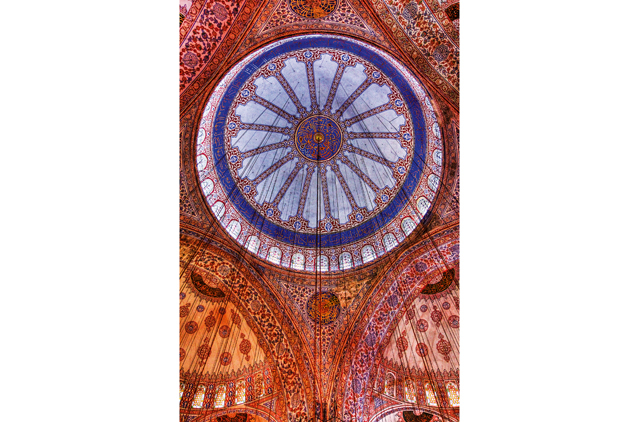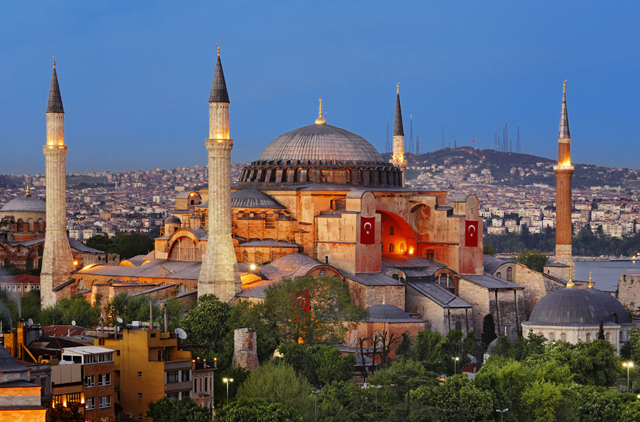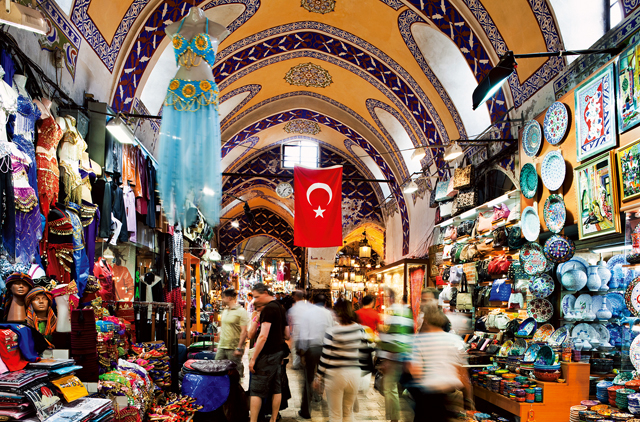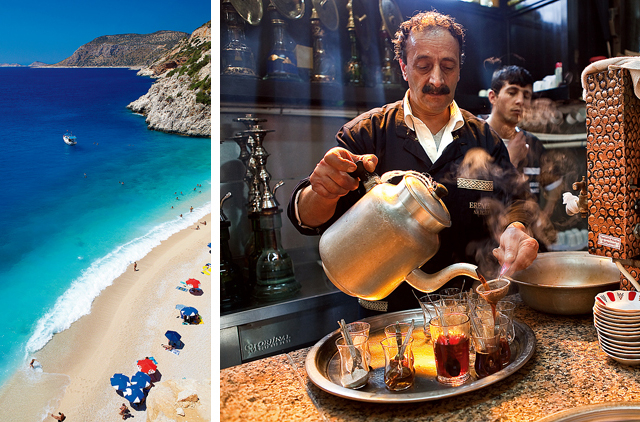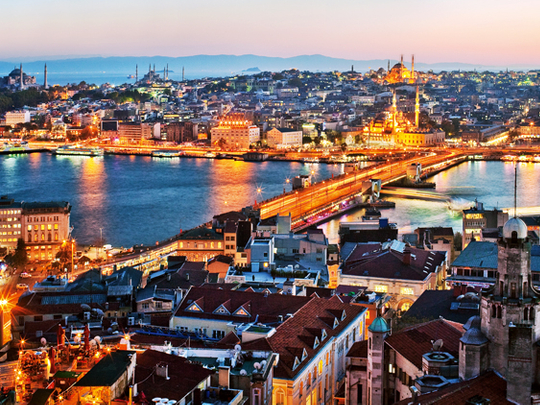
It was like a maze where time stood still. Within an hour of arriving in Istanbul, I found myself in the labyrinthine lanes of the Kapali Carsi, the city’s historic 15th-century bazaar, trying to take in the culture, sounds and vibrant colours.
The Grand Bazaar houses more than 3,000 shops in its 62 lanes, and every one is stacked with a sense of history and place, selling beautiful ceramics, hand-woven carpets, bright fabrics, intricately wrought metal and delicate stained-glass.
There had been so much negative press on Turkey before my visit – recent unrest, inflation and other economic difficulties – but the words of travel writer Freya Stark eased my mind, “Travel does what good novelists also do to the life of everyday, placing it like a picture in a frame or a gem in its setting, so that the intrinsic qualities are made more clear.” I knew I needed to put my worries aside and see for myself what this amazing country had to offer.
A haggler’s paradise
Outside on the pavement, it was rush hour. Tourists mingled with the locals in a blur of bobbing headscarves and bare heads, all in search of the bazaar’s famous but elusive bargains. If you take pleasure in haggling, you’ll likely be able to buy items for around half the advertised price. The same goes for the heady spice souq next door, where the warm aromas of star anise, nutmeg and cinnamon mingle with saffron, zataar and dried mango. But polish up your Turkish language skills first, English is rarely spoken by the shopkeepers here.
Sipping black Turkish coffee while playing backgammon at a road-side tea stall later, I felt imbued with the romanticism and keyif – a Turkish word meaning ‘pure joy’ – of this bustling, vibrant city. A medley of European sophistication and Asian vibrancy, Istanbul’s rich mosaic of culture and complex history has so much to offer its visitors who come here from all over the world.
It is said that you form your impression of a city or a place based on the hospitality you receive. Ours was grand, especially from our guide Mustafa Ozbinici, who turned out to be the most thorough host, philosopher and friend for the next six days.
I had the most unbelievable view of Istanbul from the magnificent Rixos Pera Istanbul Hotel in Taksim Square, a major shopping and transport hub in the centre of the city. Recently opened, the Rixos is an exquisite boutique hotel, housed in three buildings dating back more than 200 years, and is filled with art-deco mosaic floors, crystal chandeliers, marble columns and filigreed balustrades.
A perfect evening awaited me at Rixos Pera’s restaurant, Jack Russell, which serves gorgeous international cuisine. I was delighted to learn that Madonna even held a party there recently! But the climax of my evening was the menu created especially for my group. The chef had taken basic kebabs, cheese and greens and transformed them into the most exotic dishes – for instance, can you imagine horseradish in a sorbet? The spicy edge was softened with gentle cool sweetness.
Other highlights included the char-grilled vegetable salad with halloumi lollipops and wild thyme vinaigrette. We ended our meal and the evening with strong Turkish coffee, and that night I dreamt about Turks on horseback outside moonlit Ottoman palaces by the sea.
The morning brought another gastronomic delight. In Turkey, breakfast is not just a quick slam dunk and swallow affair but an elaborate ritual. Some things are staple and sacred. You must have the Turkish green plums, the bright, succulent cherries, apricots and peaches bursting with juices, plus some cherry tomatoes and olives. No breakfast is complete without labneh, a variety of grilled cheeses ranging from halloumi to stringed goat’s cheese, an array of freshly baked bread – especially simit, a seasame-encrusted pretzel – followed by a cup of either fruit-flavoured tea or strong coffee. There was no way I was going to stick to my diet on this trip!
Another treat for the taste buds
The rest of our programme for the day was even more indulgent. A luxurious hammam – essential when you visit Turkey – at Rixos’ spa left me feeling fresh and surprisingly hungry for the next meal, which was lucky because it turned out to be a five-course affair at the famous restaurant, Hamdi.
After savouring the view of the pier and the Bosphorus, listening to the chatter around us and marvelling at the number of people eating such extravagant meals on a work day, we tucked in. We were treated to succulent grilled vegetables, lamb, chicken and beef kebabs marinated with a variety of spices and accompanied by oven-fresh crisp Turkish breads, with generous spoonfuls of labneh on top. Course after course kept coming, and as if in a mesmeric trance we kept eating.
No Turkish meal is complete without a traditional dessert. I had the most exquisite baklava where the paper-thin sugar-coated pastry layers were sandwiched with roasted and crushed walnuts and pistachio. Food seemed to feature heavily on our agenda, with little detours around the city planned in between!
Lessons in history
Having been fed enough for a week, it was time to walk around the city, which is splitting at the seams with history – period architecture, ornate domes, minarets and gorgeous squares – that tell the country’s tales. We learnt about everything from the invasion of the Byzantine kings, the Seljuk dynasty and the Ottomans in the 14th century, to the establishment of a secular republic by Mustafa Kemal Atatürk in the 20th century, which paved the way for modern Turkey.
We visited the majestic Hagia Sophia, a museum that was first established by the Byzantine emperor Justinian the Great as a basilica and later converted into a mosque by the Ottoman rulers. Named after Saint Sophia, it has an unmistakable air of spirituality with its grand stone exterior and a majestic dome. The central hall is lit with hundreds of candles in tiered candelabras that hang from the ceiling. The exquisite frescoes, statues and sculptures are truly not to be missed.
About 500 metres from Hagia Sophia in the historical Sarayburnu district is the Yerebatan Sarayi, or the Sunken Cistern, built by Justinian the Great, 138 metres below the ground. The cistern provided a water filtration system for the Great Palace of Constantinople and other buildings, and later to the Topkapi Palace after the Ottoman conquest in 1453.
As you make your way down, it feels as if you’re walking through an enormous damp tomb, with the sound of water lapping against the stones. The dim, candle-lit cavern has an especially eerie aura. Atmospheric as it was, coming back in to the sunlight was a welcome relief.
We had just enough time to walk around the garden square of the 17th-century Sultan Ahmet Mosque (also known as the Blue Mosque) and admire its dome and minarets, which are such an important part of the city’s beautiful skyline. After a short break and some tea we got ready for a taste of the city’s nightlife and the exciting clubs and restaurants along the Bosphorous coastline. Our destination was the trendiest place in the city – Club Reina in Ortakoy, just next to the mammoth 1.5km-long bridge that connects Asia and Europe. We enjoyed the light breeze on the terrace and watched the glittering cruise ships go by – it was truly magical to be sitting at the junction of two continents.
After dinner the tables and chairs are folded away and the space turns into a giant dance floor. Guests clad in dinner finery soon gave way to people in trendy clubbing attire. Over 1,000 people moved to the music that boomed from massive speakers. The goosebumps on my body lasted all night as I lived out this rhapsodic evening in this dramatic setting.
All-inclusive family fun
After the sound and light experience at Club Reina, flying to the verdant green Mediterranean retreat in Antalya in the southwest of Turkey the next day gave me the opportunity for another kind of Turkish delight.
The sprawling five-star Rixos Premium Belek Hotel has everything anyone might need on a holiday, including a 650-metre long private beach; a swimming pool with the biggest water park in the region; chalets along a water canal; musical fountains; tennis courts; a gym; a dolphinarium; international, Mediterranean and Turkish restaurants; a shopping arcade; a large Turkish spa; 3D movie theatre and a night club. The all-inclusive rates include meals at any of the restaurants, use of many of the facilities, some spa features and water slides.
You don’t need to leave the complex and can plan a riotous family holiday in the resort bordered by the majestic Taurus mountains. Over the next two days I enjoyed another unforgettable pampering session at the Turkish hammam, had more fabulous meals at the beautiful restaurants, enjoyed shows like belly dancing, musical fountain and a beauty contest, and ended several nights shaking a leg at the club.
On the final morning as my group sat on the bus for our drive to the airport, a hostess wearing the ornate textiles of traditional Turkish dress poured water on the ground from a pot, which she said symbolised the fact that we must return to Turkey. I felt like a child mesmerised by breathtaking vignettes. The trip gave me a strong sense of tradition and modernity in the country, the rustic charms and urban sensations.
Flying back to Dubai, I felt I was coasting on the last remnants of Turkish keyif swirling around me like a heady scent. I looked at the pictures – on my camera and in my memory – and smiled as I recalled the luxurious hospitality of Rixos. Feeling sufficiently pampered, I was happy putting the finishing touches on the personal frame that features images of this unforgettable trip – just like Stark had said. This is Turkey through my eyes, one you would never find in any other travel book!


